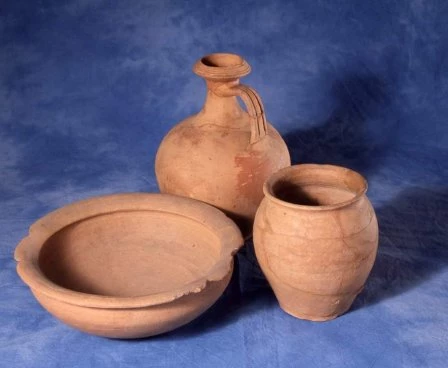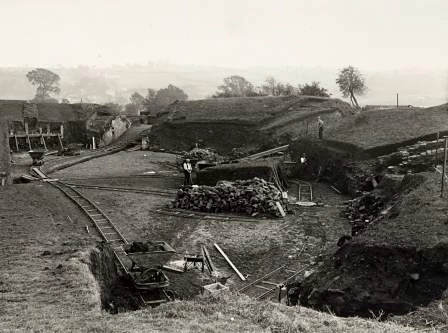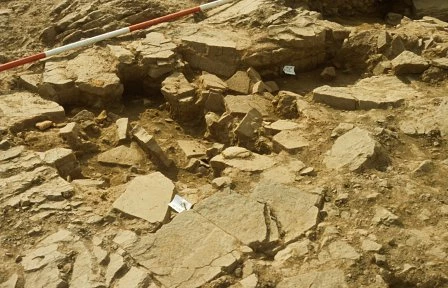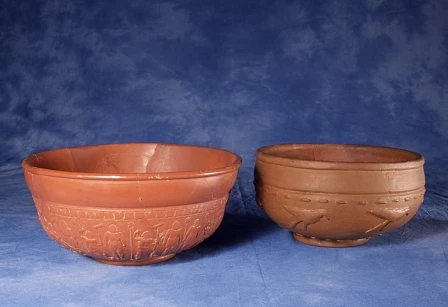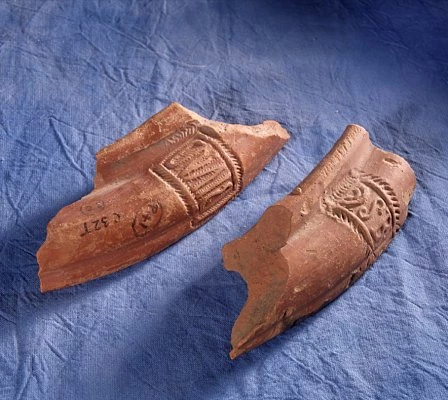Roman pottery factory discovered beneath Celtic Manor golf course
Mass produced Pottery in Roman Wales
Jar, bowl and flagon in Caerleon red-slipped ware. Soil conditions have all but destroyed the red-slipped surfaces, however, substantial patches still survive on the flagon at the rear of this group.
Study of a unique type of pottery from the Roman fortress at Caerleon, south Wales, sheds light on the relationship between local civilians and the army in Roman Wales.
Pottery was a mass-produced commodity in the Roman world and provides an important resource for archaeologists researching this period.
Different fashions in the shapes and fabrics of Roman pottery allow archaeologists to identify pottery industries: their production areas, trade routes, and date their rise and fall. Wales was home to several of these pottery industries, one of which has been the subject of study and debate since the late 1920s.
Pottery at Caerleon
Sir Mortimer Wheeler's excavations at the Caerleon Roman amphitheatre.
It was during the excavations at the Roman amphitheatre at Caerleon that the pioneering archaeologist Sir Mortimer Wheeler first identified a group of fine, well made pottery including jugs, bowls, plates, and beakers. Many of these seemed to imitate the forms of metal and samian pottery vessels imported from the continent.
Since Caerleon was home to the second Augustan legion it seemed reasonable to assume that these pots were directly linked to the Roman army.
Roman tableware
The kiln at Abernant during excavation at the Celtic Manor resort in 1996. The pottery to be fired would be stacked on a fired clay floor over the pit in the centre of the image. Photo © Peter Webster.
Wheeler believed he had discovered the tableware used by the legion in the 2nd century AD.
Further excavations have found this type of pottery at Roman sites in and around Caerleon. With so much being discovered, it seemed obvious that it had been produced locally, and it became known as Caerleon Ware. The question was where?
It took another seventy years of work at Caerleon before this question was answered on the Celtic Manor golf course 1.6 miles (2.6 km) north-east of the fortress.
Celtic Manor Golf Course
Caerleon Ware was produced in imitation of well known continental types such as Samian. On the left is an authentic Samian bowl, and on the right the less-defined Caerleon Ware imitation.
In 1996, as the Celtic Manor golf course was being built, archaeologists revealed a kiln and the remains of several buildings - possibly drying sheds. The kiln contained a range of broken Caerleon Ware pots.
The Abernant kiln provided proof that the pottery, which Wheeler had grouped together, was made locally. But another question remains unanswered: who were the potters?
Wheeler believed that the potters were Roman soldiers. However, a close look at the 'name' stamps used on the large mixing bowls (mortaria) suggested the potters were illiterate - unlike the stamps used on tiles which were clearly literate.
If the makers of the pots were illiterate, they were probably not soldiers, but local civilians. Also the pottery was being made at a time when large sections of the legion were away in northern Britain.
It would appear that some enterprising civilians had set up business to supply the legion with pottery in a style that it recognised.
Background Reading
Not all of the Caerleon potters were literate. On the right is a stamp on the rim of a bowl on which the initials 'S. B.' can be seen. On the left is a stamp produced by an illiterate potter. Here the letters have become stylised shapes.
'Bulmore, Celtic Manor golf course, No. 3' by B. C. Burnham. In Brittania vol. 28, p401-2 (1997).
'The Roman amphitheatre at Caerleon, Monmouthshire' by T. V. and R. E. M Wheeler. In Archaeologia vol. 78, p111-218 (1928).
